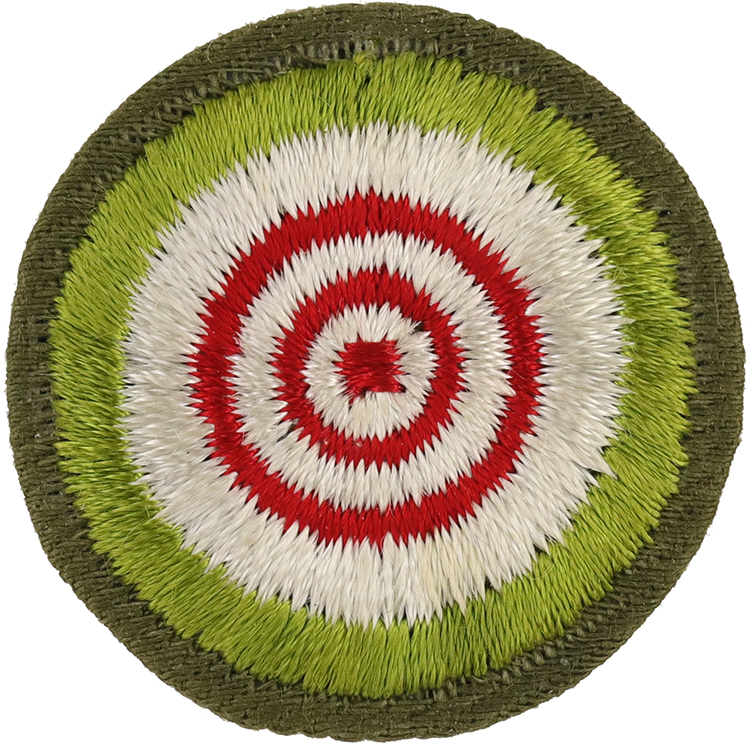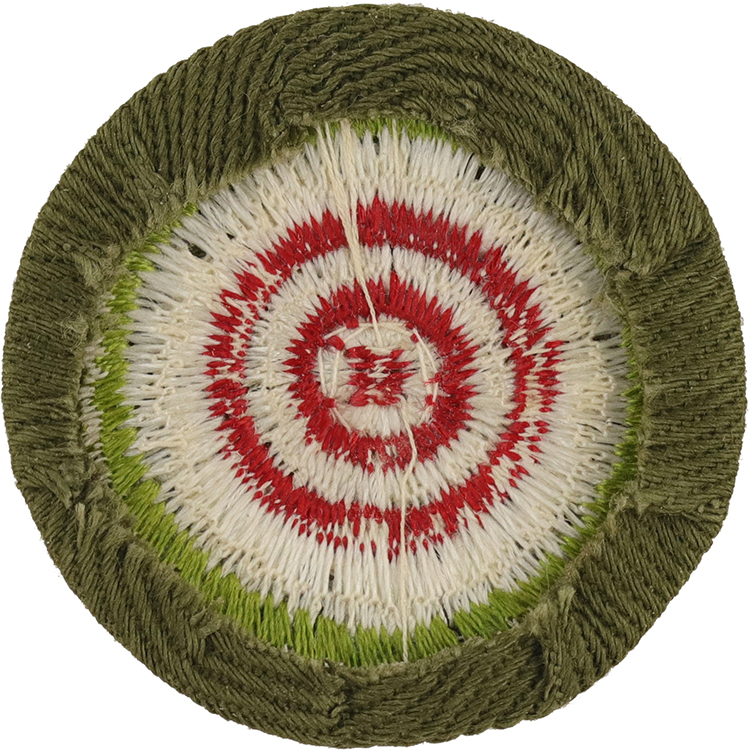
Fig. 1: Marksm-E2-Front
- Cloth: Khaki right twill
- Embroidery: Cotton lock stitch

Fig. 2: Marksm-E2-Reverse
- Back: Plain NO imprint with starch

Fig. 3: Marksm-E2-mve1-front
- Minor variation: Wide light border

Fig. 4: Marksm-E2-mve1-reverse
- Back: Plain NO imprint with starch
Item Name: Marksmanship 1947 - 1960
Item ID: Marksm-E2
Collector Rating: 1
Requirements September 1934 until June 1953
1. (a) Make not less than 30 points in the off-hand position (standing) out of a possible 50 points, in 5 shots, on each of four targets, at a distance of fifty feet from firing point to target.
(b) Make a score of not less than 40 points in the prone position out of a possible 50 points, in 5 shots, on each of six targets, at a distance of fifty feet from firing point to target.
(c) All shooting must be witnessed and targets signed by a range officer whose appointment has been approved by the Local or National Council.
2. (a) Pledge his word that he will live up to the Boy Scout Marksman's Code.
(b) Explain his understanding of the meaning of the first four rules of safety in the Boy Scout Marksman's Code, and demonstrate Nos. 2, 3, and 4.
3. (a). Demonstrate with a rifle:
1. The proper way to clean it after using;
2. What rifling is, and explain the function of rifling;
3. In what direction the rear sight should be moved, to move the striking point of the bullet (a) from right to left; (b) from below the target upward to the target (sights need not be actually moved for this demonstration).
(b) Explain the proper method of removing rust and leading from the bore of a rifle.
Boy Scout Marksman's Code
1. A Scout considers every gun as being loaded, even though he has personally unloaded it.
2. A Scout points the muzzle of a gun in a safe direction on picking it up.
3. A Scout opens the action of a gun immediately and makes sure that it is not loaded.
4. A Scout opens the action of the gun before he passes it to another person.
5. A Scout takes care not to heedlessly point a gun at any human being under any circumstances.
6. A Scout turns the muzzle of a firearm away from every person when loading it.
7. A Scout strives to preserve harmless animals and birds, and does not wantonly shoot or kill merely for the sake of killing.
8. A Scout takes every precaution for the safety of others before shooting in the open.
9. A Scout cares for a firearm properly before he lays it aside.
10. A Scout is sportsmanlike when engaged in contests of skill with firearms and whenever handling firearms.
Conditions
RIFLE: Any .22 caliber rimfire.
SIGHTS: Any not containing glass.
TARGETS: Fifty-foot official Boy Scout Marksman or N.R.A. Target, 2 to 10 Count.
RANGE: Fifty feet from firing point to target.
GUN SLING: Gun sling may be used in connection with one arm only. It may not be placed around any other portion of the body. It may be attached only to fore end and butt.
POSITIONS--Standing: Erect on both feet, all other portions of body free from all artificial support. Use of sling allowed.
Military or hip rest position with elbow on hip and rifle resting on tips of fingers optional. The use of belt to assist in holding elbow in this position is not permitted.
Prone: Body extended on the ground, head toward target; no portion of arms except the elbows shall rest on ground, floor, or any artificial support, rifle to be free from any artificial support. Use of sling allowed.
Requirements June 1953 until September 1961
1. (a) Pledge your word that you will live up to the Scout Marksman's Code. (b) Explain your understanding of the meaning of each of the rules of safety in the Scout Marksman's Code. (c) Explain what different kinds of weapons are meant by the word "gun" as it is used in the Scout Marksman's Code.
2. Demonstrate with a rifle or shotgun: (a) the very first thing you must do whenever you take up a gun or whenever a gun is handed to you by another person; (b) the proper way to carry a gun afield if you are walking with two companions [show how each of the three persons should carry his gun (1) when walking single file and (2) when walking abreast]; (c) how to properly hand a gun to another person; (d) how to properly take a gun from an automobile; (e) how to properly handle a gun when it is necessary to cross a fence; (f) the proper care a gun requires after use--(1) when in daily use and (2) when storing it for a long period of time.
3. Describe what "rifling" is and explain its function.
4. In what direction should the rear sight of a gun be moved to move the striking point of the bullet: (a) from right to left? (b) from too low to "on target"?
5. (a) Make not less than 30 points in the offhand (standing) position out of a possible 50 points (5 shots) on each of four targets. (b) Make a score of not less than 40 points in the prone position out of a possible 50 points (5 shots) on each of six targets.
NOTE: You may qualify for Requirements 5a and 5b on any one of the following courses of fire: (1) 50-foot course may be fired with .22 caliber rim-fire rifles using .22 short, long, or long rifle ammunition, using official 50-foot targets on a 50-foot range. (2) 25-foot course may be fired with .22 caliber rim-fire rifles using .22 caliber CB or BB caps, pneumatic or gas type air rifles not greater than .22 caliber, using 50- or 25-foot targets on a 25-foot range. (3) 15-foot course may be fired with any spring-type air rifle (BB gun) using official 15-foot air rifle targets on a 15-foot range.
Specifications: Range distance of 50, 25, or 15 feet is measured from firing line to face of target. Sights can be any not containing glass. Targets must be official NRA, official BSA, or those issued by the director of Civilian Marksmanship. Rifle sling may be used in connection with arm and hand supporting the fore end. No other use of the sling is permitted.
The Scout Marksman's Code
1. A Scout always treats every gun, whether it is a rifle, a shotgun, an air gun, or a handgun, as a loaded gun--even though he has personally unloaded it.
2. A Scout points the muzzle of a gun in a safe direction when picking it up and laying it down.
3. A Scout opens the action of a gun immediately and makes sure that it is unloaded.
4. A Scout opens the action of a gun before he passes it to another person.
5. A Scout never points a gun, loaded or unloaded, toy or real, at any human being under any circumstances.
6. A Scout always follows the principles and practices of wildlife conservation and lives up to the spirit and letter of all game laws.
7. A Scout takes every precaution for the safety of others before shooting in the open.
8. A Scout cares for a firearm properly before he lays it aside.
9. A Scout is sportsmanlike when engaged in contests of skill with firearms and whenever handling firearms.
10. A Scout pledges never to shoot at anything he cannot positively identify.
11. A Scout knows and complies with the laws governing the use of firearms in his community and state.



